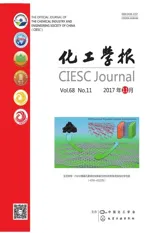癸酸甲酯、月桂酸甲酯和肉豆蔻酸甲酯的液相声速测量
2017-11-22陈玉田张颖郑雄何茂刚
陈玉田,张颖,郑雄,何茂刚
(西安交通大学热流科学与工程教育部重点实验室,陕西 西安 710049)
癸酸甲酯、月桂酸甲酯和肉豆蔻酸甲酯的液相声速测量
陈玉田,张颖,郑雄,何茂刚
(西安交通大学热流科学与工程教育部重点实验室,陕西 西安 710049)
癸酸甲酯、月桂酸甲酯和肉豆蔻酸甲酯3种脂肪酸甲酯是生物柴油的主要成分,其声速是喷油系统优化设计和等熵压缩因子计算中所必需的参数之一。针对癸酸甲酯、月桂酸甲脂和肉豆蔻酸甲脂3种物质声速实验数据缺乏的现状,利用布里渊光散射法,沿0.1、2.5、5.5和8.5 MPa 4条等压线,在288.15~498.15 K温度范围内,分别测量了癸酸甲酯、月桂酸甲酯和肉豆蔻酸甲酯的液相声速;分析了声速随温度、压力的变化规律;依据实验数据,给出了在本文p-T热力学区域内,3种物质液相声速与温度和压力的关联式;关联式计算值与实验数据的相对偏差绝对平均值分别为:0.17%(癸酸甲酯)、0.10%(月桂酸甲酯)和0.15%(肉豆蔻酸甲酯),满足工程应用需求。
生物柴油;声速;布里渊光散射;测量
引 言
生物柴油具有可再生性、良好的生物降解性、无毒、更高的辛烷值、良好的抗氧化性以及可有效降低温室气体排放等显著优点,并且可直接应用于现有的柴油机中。因此,越来越多地引起了各国学者们的广泛关注[1-2]。
生物柴油的主要成分为脂肪酸甲酯(FAMEs)和脂肪酸乙酯(FAEEs)。由于这些脂肪酸类物质的化学结构不同,导致其热物理特性(如密度、声速、表面张力和黏度等)与现用柴油间均存在明显的差异。这些热物性的改变将直接影响柴油机的喷油时间,而喷油过程设计是柴油机组织燃烧和降低燃料消耗以及废气排放的关键环节[3-4]。在柴油机喷油设计中必需的热物性参数有表面张力、黏度和等熵压缩因子,其中等熵压缩因子是通过密度和声速计算得到的[5]。因此,生物柴油的精确声速数据在喷油系统优化设计中起到了重要作用。
本文对处于研究热点的3种脂肪酸甲酯——癸酸甲酯、月桂酸甲酯和肉豆蔻酸甲酯的文献声速实验数据进行了整理分析(表1)。可见,癸酸甲酯、月桂酸甲酯和肉豆蔻酸甲酯声速的实验研究可追溯到20世纪60年代。近年来,随着生物柴油研究的逐步深入和大量的推广应用,上述3种脂肪酸酯的声速研究也随之增多,其中,Daridon等[5-13]开展了一系列癸酸甲酯、月桂酸甲酯和肉豆蔻酸甲酯声速的实验研究,并且报道了一些高压下的液相声速数据。然而,大多数文献实验数据均集中在常压下(或者压力梯度很大,压力上限210 MPa)和较小的温度区间(温度上限403.15 K)内,使得现有声速实验数据在p-T热力学面上存在大量空白区域,显然不能满足相关研究的需求,如建立高精度的声速预测模型等。
鉴于此,本文将集中开展癸酸甲酯、月桂酸甲酯和肉豆蔻酸甲酯3种脂肪酸甲酯液相声速的实验测量工作,旨在补充上述3种物质的高精度声速实验数据。测量沿0.1、2.5、5.5和8.5 MPa 4条等压线进行,所覆盖的温度范围为288.15~493.15 K。此外,本文选用Daridon等[5,7]提出声速关联式对本文所测量的p-T范围内3种脂肪酸甲酯液相声速实验数据进行了关联,以满足工程需要。
1 实验材料和方法
1.1 材料
表2依次给出了3种脂肪酸甲酯——癸酸甲酯、月桂酸甲酯和肉豆蔻酸甲酯的CAS登记号、供应商信息、质量分数以及基本物化性质。3种试剂纯度(质量分数)均优于0.990。实验前利用孔径为0.22 μm的薄膜过滤器对实验样品进行过滤,此外没有经过进一步的提纯。
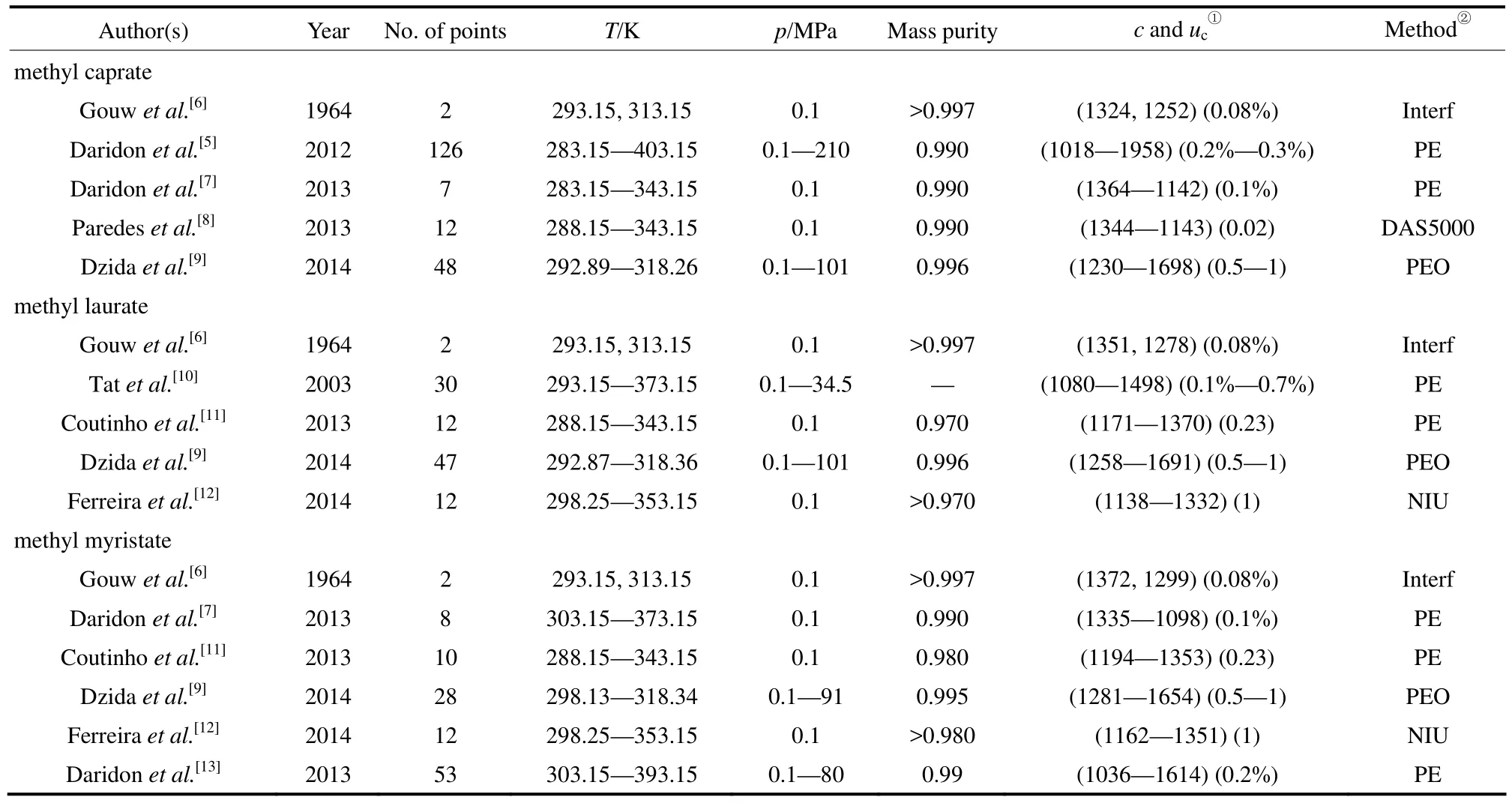
表1 癸酸甲酯、月桂酸甲酯和肉豆蔻酸甲酯的文献声速实验数据汇总Table 1 Literature reports on experimental speed of sound in methyl caprate, methyl laurate and methyl myristate

表2 3种脂肪酸甲酯样品信息及基本物化性质Table 2 Specification of three FAMEs samples
1.2 实验系统
测量流体声速的经典方法主要有共振干涉法和脉冲法,国内外众多研究者都开展此两种方法的研究工作,如德国波鸿大学的 Span等[14]、清华大学的段远源等[15]以及作者所在的课题组[16]等。布里渊散射法是一种光学流体声速测量方法。德国埃尔朗根-纽伦堡大学的Leipertz课题组多年来一直致力于该方法的研究工作[17-19]。详细的布里渊散射法流体声速测量原理可参见作者课题组前期的研究报道[20-22]以及一系列相关研究工作[23-25]。限于篇幅,此处仅对该方法工作方程进行简要介绍。
分子的热运动诱发热声波,该热声波为各种波长声波的混合。当激光射入介质时,介质内的等熵压力涨落诱发介质产生自发布里渊散射,而热声波作为衍射光栅对散射光形成周期性功率调制。根据布拉格定律,可以计算得到散射矢量(入射光的波矢量与散射光波矢量之差)的模为

式中,kI为入射光波矢量,n为样品折射率,λ0为入射光在真空中的波长,Θs和ΘEx分别为散射角和入射角。激光透射样品,诱导其发出散射光,散射光频谱中会出现两个对称分布的布里渊峰。根据多普勒频移定律,散射光频移与样品声速有关

式中,Δω为散射光频移,ω0为入射光频率,c为样品声速,c0为真空光速。
结合式(1)和式(2),可以得到声速与散射光频移的关系为

当测量得到布里渊峰的频移后,可由式(3)计算得到样品声速。本文利用光电倍增器结合Fabry-Perot干涉仪测量布里渊峰频移,图1给出了一个典型的实验频谱图。

图1 散射光频谱图Fig.1 Scattered light spectrum
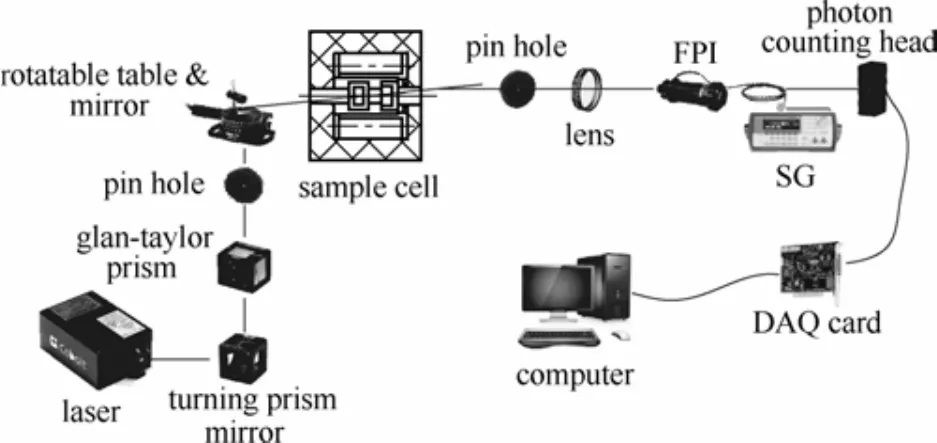
图2 布里渊散射光路示意图Fig.2 BLS experimental setup
本文采用的光散射系统及温度/压力测控单元在本课题组前期的研究报道中均已详述[20,26],图2为本文所采用的布里渊散射光路,以下仅对主要实验仪器进行简单介绍。激光器为Cobolt公司生产的SambaTM系列激光器,波长532 nm,功率300 mW;Fabry-Perot干涉仪型号SA200-5B,Thorlabs公司;光电倍增器型号H8259-01,Hamamatsu公司生产。温度测量采用铂电阻温度传感器(PRT,Fluke,测量标准不确定度为0.01 K),布置于散射池内;压力测量采用压力变送器(Rosemount,量程0~20 MPa,测量标准不确定度为5 kPa)。声速测量不确定度主要由3部分组成,分别为:布里渊频率不确定度、入射光波长不确定度和入射角不确定度。综合三者影响,最终本文声速测量的相对扩展不确定度为:< 1% (置信因子取2),测量不确定度分析详见文献[26-27]。
2 实验结果与讨论
本文沿4条等压线0.1、2.5、5.5和8.5 MPa,测量了温度288.15~498.15 K范围内,癸酸甲酯、月桂酸甲酯和肉豆蔻酸甲酯的液相声速。每个实验点单独测量4次,取平均值作为测量值,实验数据的复现性优于0.2%。
表3和图3~图5给出了癸酸甲酯、月桂酸甲酯和肉豆蔻酸甲酯的声速实验数据。对此3种脂肪酸酯而言,在本文研究的p-T热力学区域内,其液相声速随着压力升高略有增大且增大的趋势随着压力的升高逐渐变大;随着温度的升高,其液相声速显著降低;沿等压线,声速随温度的变化基本呈现线性关系。此外,对比3种脂肪酸酯的液相声速数据可以发现,随着碳原子数的增加,声速值逐渐增加。
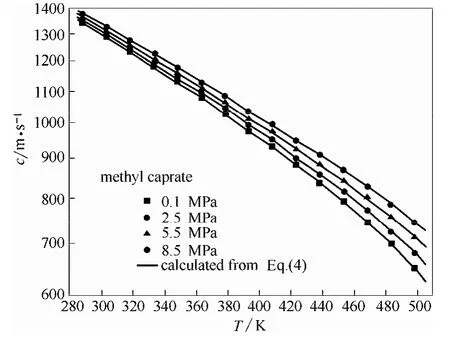
图3 癸酸甲酯实验数据Fig. 3 Experimental speed of sound in methyl caprate
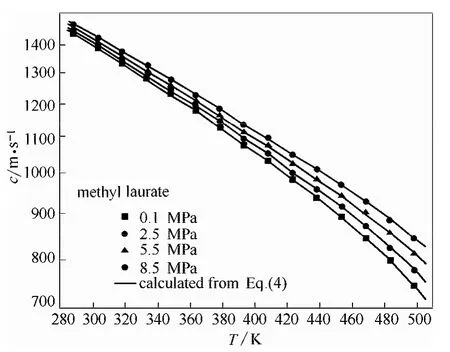
图4 月桂酸甲酯实验数据Fig. 4 Experimental speed of sound in methyl laurate
据文献报道,常被推荐用来计算脂肪酸酯类物质液相声速的模型有:Wada基团贡献法模型[8]和Auerbach模型[11],但这两个计算模型均需要物质的密度数据,然而在本文的实验温度范围内,无法获取精确的癸酸甲酯、月桂酸甲酯以及肉豆蔻酸甲酯的液相密度数据。
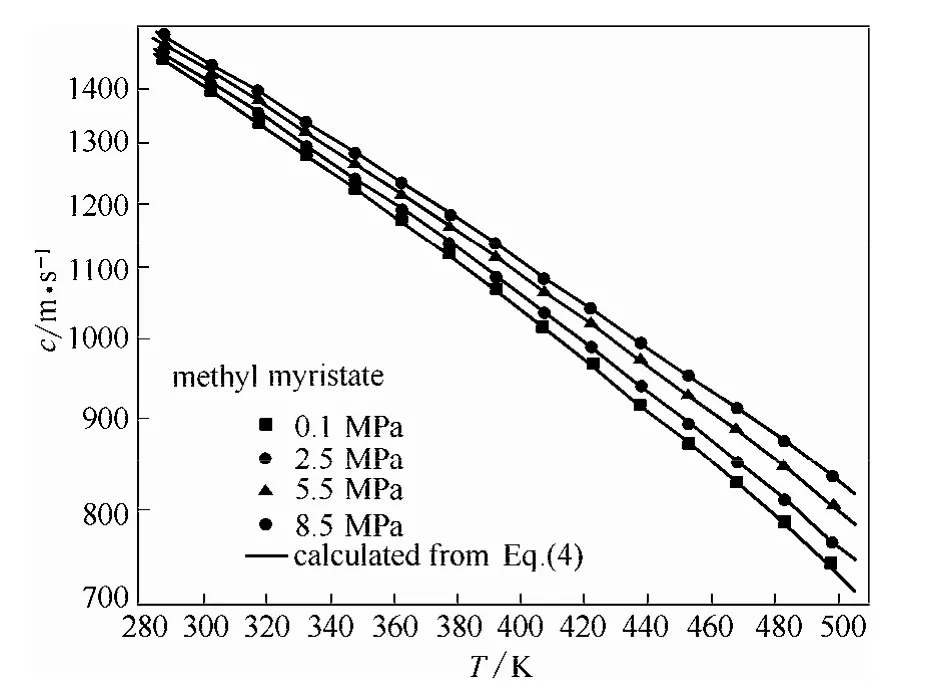
图5 肉豆蔻酸甲酯实验数据Fig. 5 Experimental speed of sound in methyl myristate
因此,本文选取了Daridon等[28-30]提出的一个关于1/c2的声速计算模型,对测量得到的实验数据进行了关联。该模型直接将声速关联为温度、压力的函数,并且,曾被用于正十八烷、正十九烷以及芳香烃类等多种高碳原子数的物质液相声速计算且具有较好的计算精度。该模型方程形式如下

式中,c为声速,m·s-1;T为流体温度,K;p为流体压力,MPa;A0~F为关联系数。表4给出了3种物质方程式(4)中的系数和方程的计算偏差。结合图3~图5中方程曲线可以看出,方程计算值与实验值具有良好的一致性。
本文将式(4)计算得到的 0.1 MPa下的癸酸甲酯、月桂酸甲酯和肉豆蔻酸甲酯的声速数据与文献实验数据进行了比较,如图6~图8所示。
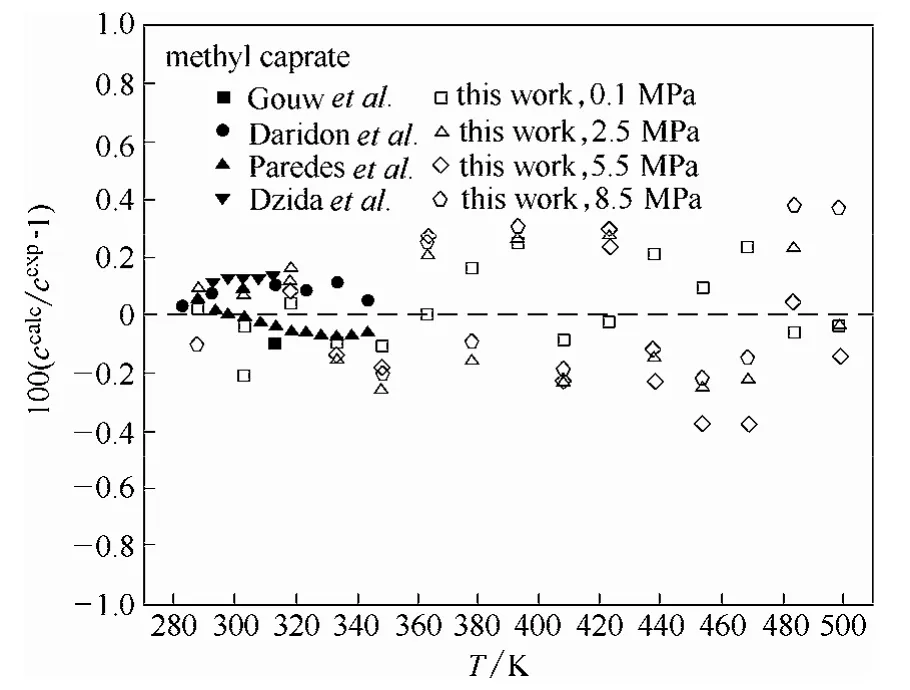
图6 癸酸甲酯计算偏差Fig. 6 Deviation of sound speed in methyl caprate from different authors compared to Eq. (4)
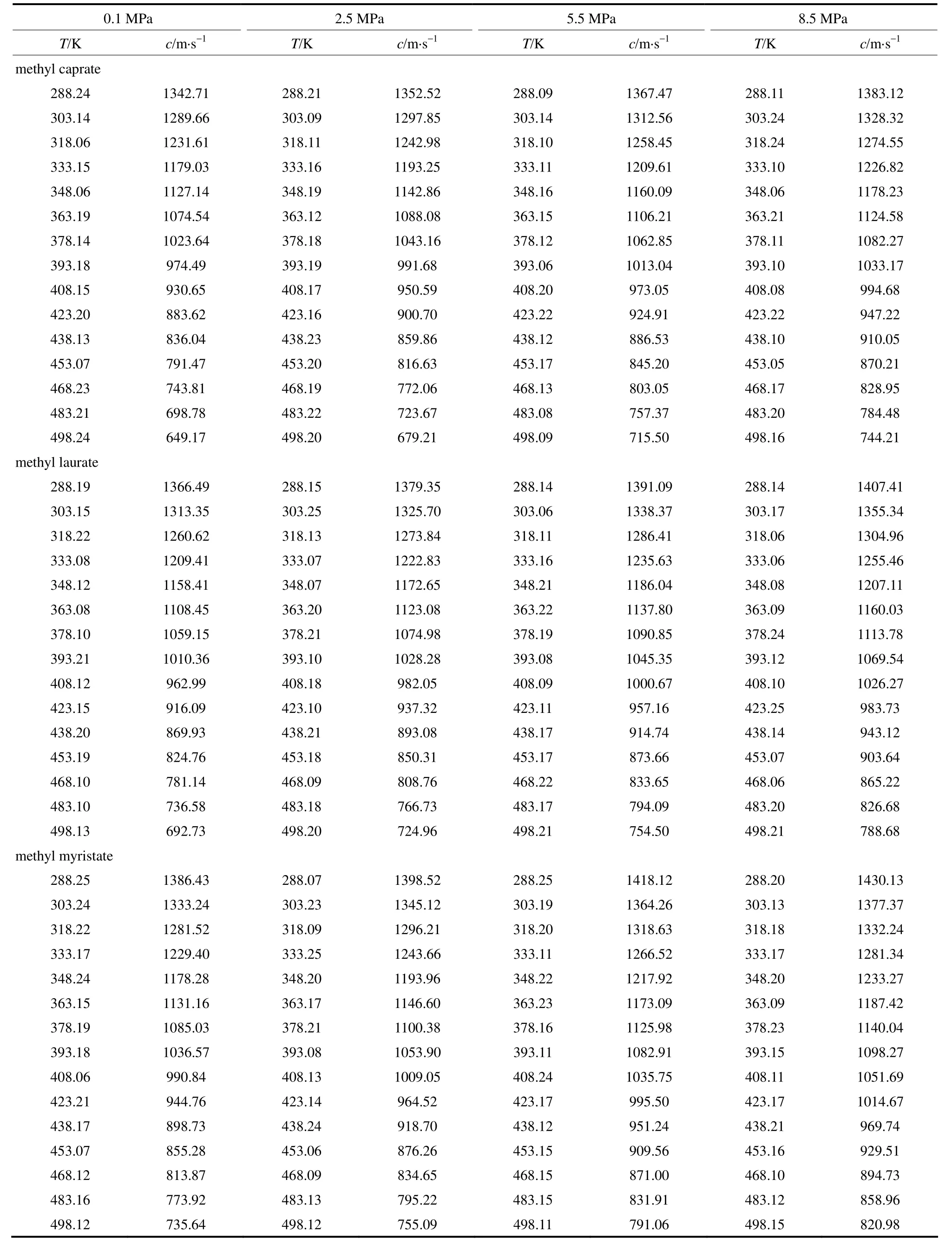
表3 癸酸甲酯、月桂酸甲酯和肉豆蔻酸甲酯的声速实验数据Table 3 Experimental speed of sound in liquid methyl caprate, methyl laurate and methyl myristate
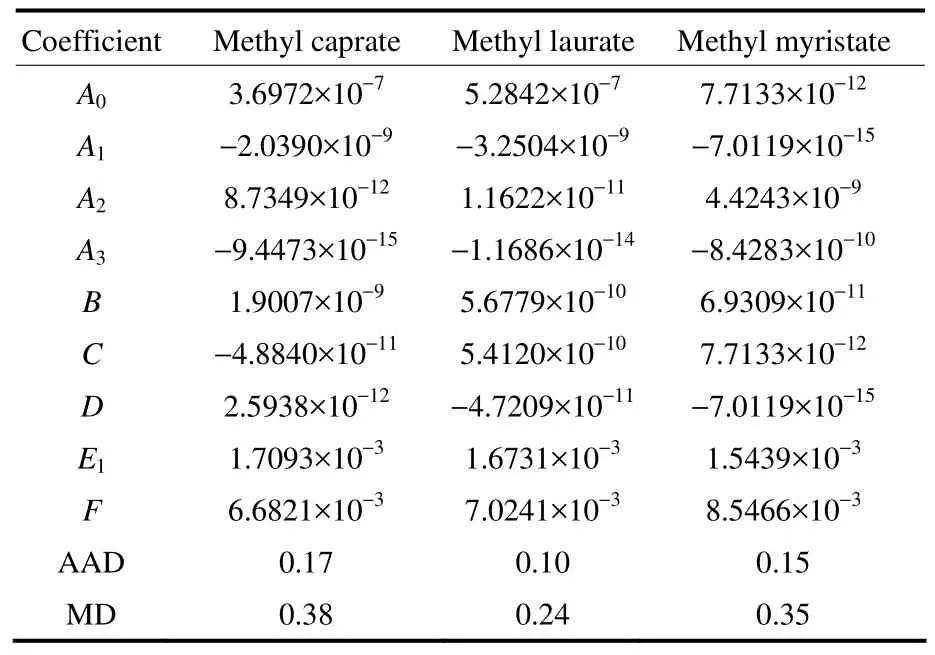
表4 关联式(4)系数及其计算偏差Table 4 Fitted coefficients in Eq. (4)
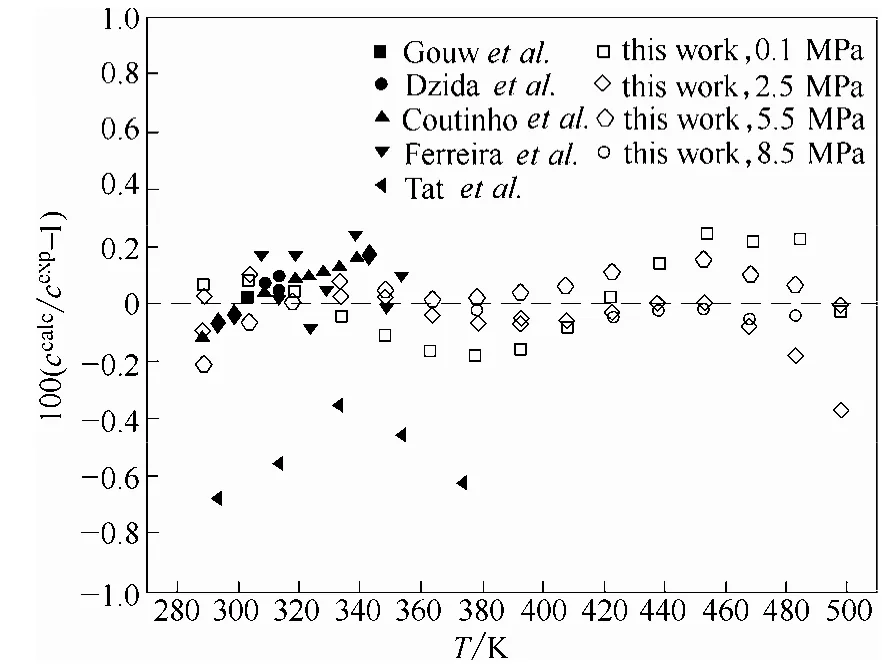
图7 月桂酸甲酯计算偏差Fig. 7. Deviation of sound speed in methyl laurate from different authors compared to Eq. (4)
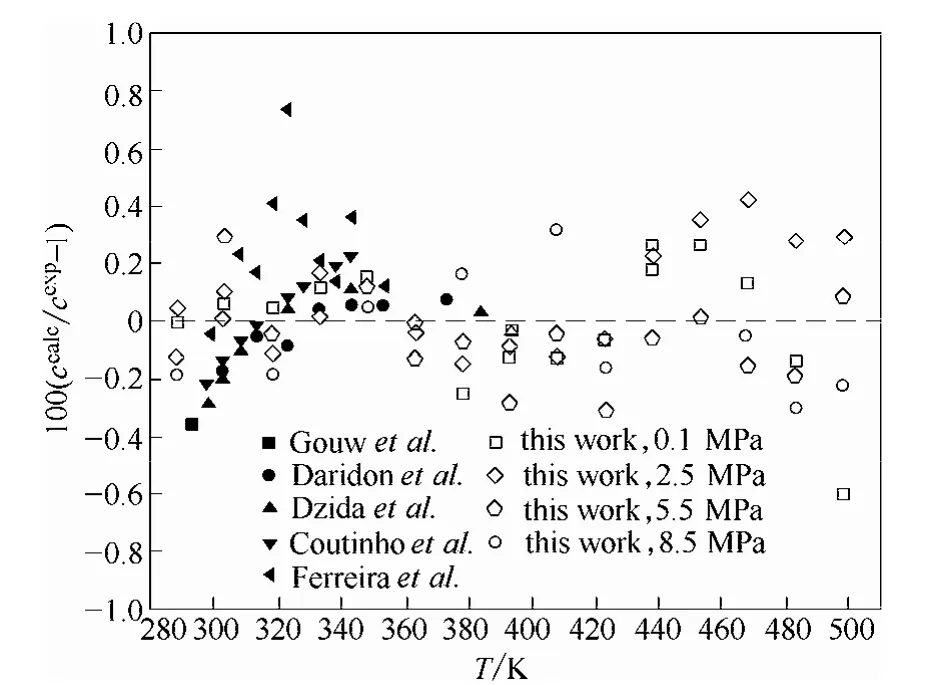
图8 肉豆蔻酸甲酯计算偏差Fig. 8 Deviation of sound speed in methyl myristate from different authors compared to Eq. (4)
癸酸甲酯计算值与文献实验数据的相对偏差绝对平均值为0.08%,绝对偏差平均值为0.95 m⋅s-1;月桂酸甲酯计算值与Gouw等、Dzida等、Coutinho等和 Ferreira等报道的文献实验数据的相对偏差绝对平均值为0.08%,绝对偏差平均值为1.05 m⋅s-1;与Tat等报道的实验数据的相对偏差绝对平均值为0.54%,绝对偏差平均值为6.54 m⋅s-1,原因在于Tat等选取的月桂酸甲酯实验试剂可能被污染,纯度受到影响;肉豆蔻酸甲酯计算值与文献实验数据的相对偏差绝对平均值为 0.15%,绝对偏差平均值为1.87 m⋅s-1。由此可见,本文的实验数据与文献数据吻合良好,关联方程具有较高的计算精度。
3 结 论
本文针对癸酸甲酯、月桂酸甲酯和肉豆蔻酸甲酯 3种主要的生物柴油组分物质声速实验数据缺乏、现有实验数据覆盖温度区间狭窄的研究现状,利用课题组自行搭建的布里渊光散射实验系统测量了这3种脂肪酸甲酯的液相声速。该实验系统的温度、压力测量的不确定度分别为0.01 K和5 kPa,声速测量的相对扩展不确定度小于 1%。本文的测量温度范围为288.15~498.15 K,压力为0.1、2.5、5.5和8.5 MPa,获取了癸酸甲酯、月桂酸甲酯和肉豆蔻酸甲酯的液相声速实验数据共计180个。同时,分析了声速随温度、压力的变化规律。为方便相关科研及工程领域的应用,依据Daridon等提出的声速计算模型,给出了在本文p-T热力学区域内,3种物质液相声速的计算方程,方程计算精度分别为:0.17% (癸酸甲酯)、0.10% (月桂酸甲酯)和 0.15% (肉豆蔻酸甲酯)。
[1] BENJUMEA P, AGUDELO J R, AGUDELO A F. Effect of the degree of unsaturation of biodiesel fuels on engine performance, combustion characteristics, and emissions[J]. Energy &Fuels, 2011, 25(2): 77-85.
[2] 李为民, 郑晓林, 徐春明, 等.固体碱法制备生物柴油及其性能[J]. 化工学报, 2005, 56 (4):711-716.LI W M, ZHENG X L, XU C M,et al. Preparation and its properties of biodiesel by using solid base catalyst[J]. Journal of Chemical Industry and Engineering, 2005, 56 (4): 711-716.
[3] CARESANA F. Impact of biodiesel bulk modulus on jnjection pressure and injection timing. The effect of residual pressure[J]. Fuel,2011, 90(2): 477-485.
[4] BOEHMAN A L, MORRIS A D, SZYBIST J,et al. The impact of the bulk modulus of diesel fuels on fuel injection timing[J]. Energy &Fuels, 2004, 18(6): 1877-1882.
[5] NDIAYE E H I, NASRI D, DARIDON J L. Speed of sound, density,and derivative properties of fatty acid methyl and ethyl esters under high pressure: methyl caprate and ethyl caprate[J]. Journal of Chemical & Engineering Data, 2012, 57(10): 2667-2676.
[6] GOUW T H, VLUGTER J C. Physical properties of fatty acid methyl esters(Ⅳ): Ultrasonic sound velocity[J]. Journal of the American Oil Chemists’ Society, 1964, 41(8): 524-526.
[7] DARIDON J L, COUTINHOB J A P, NDIAYEA E H I, et al. Novel data and a group contribution method for the prediction of the speed of sound and isentropic compressibility of pure fatty acids methyl and ethyl esters[J]. Fuel, 2013, 105(1): 466-470.
[8] FREITAS S V D, CUNHA D L, REIS R A, et al. Application of Wada’s group contribution method to the prediction of the speed of sound of biodiesel[J]. Energy & Fuels, 2013, 27(3): 1365-1370.
[9] ŻARSKA M, BARTOSZEK K, DZIDA M. High pressure physicochemical properties of biodiesel components derived from coconut oil or babassu oil[J]. Fuel, 2014, 125(11): 144-151.
[10] TAT M, GERPEN J H V. Measurement of biodiesel speed of sound and its impact on injection timing[R]. Colorado: National Renewable Energy Laboratory, 2003.
[11] FREITAS S V D, PAREDES M L L, DARIDON J L, et al.Measurement and prediction of the speed of sound of biodiesel fuels[J]. Fuel, 2013, 103(1): 1018-1022.
[12] LOPES A F G, TALAVERA-PRIETO M D C, FERREIRA A G M,et al. Speed of sound in pure fatty acid methyl esters and biodiesel fuels[J]. Fuel, 2014, 116(1): 242-254.
[13] NDIAYE E H I, HABRIOUX M, COUTINHO J A P, et al. Speed of sound, density, and derivative properties of ethyl myristate, methyl myristate, and methyl palmitate under high pressure[J]. Journal of Chemical & Engineering Data, 2013, 58(5): 1371-1377.
[14] DÁVILA M J, GEDANITZ H, SPAN R. Speed of sound measurements of liquid C1—C4alkanols[J]. Journal of Chemical Thermodynamics, 2016, 93: 157-163.
[15] LIU Q, FENG X J, AN B L, et al. Speed of sound measurements using a cylindrical resonator for gaseous carbon dioxide and propene[J]. Journal of Chemical & Engineering Data, 2014, 59(9):2788-2798.
[16] HE M G, LIU Z G, YIN J M. Measurement of speed of sound with a spherical resonator: HCFC-22, HFC-152a, HFC-143a and propane[J].International Journal of Thermophysics, 2002, 23(6): 1599-1615.
[17] FRÖBA A P, BOTERO C, LEIPERTZ A. Thermal diffusivity, sound speed, viscosity, and surface tension of R227ea (1,1,1,2,3,3,3-heptafluoropropane)[J]. International Journal of Thermophysics,.2006, 27(6): 1609-1625.
[18] FRÖBA A P, KREMER H, LEIPERTZ A, et al. Thermophysical properties of a refrigerant mixture of R365mfc (1,1,1,3,3-pentafluorobutane) and galden® HT 55 (perfluoropolyether)[J].International Journal of Thermophysics, 2007, 28(8): 449-480.
[19] WILL S, FRÖBA A P, LEIPERTZ A. Thermal diffusivity and sound velocity of toluene over a wide temperature range[J]. International Journal of Thermophysics, 1998, 19(2): 403-414.
[20] 王升. 激光散射法流体热扩散率和声速测量实验系统的研制及应用[D]. 西安: 西安交通大学, 2014.WANG S. Development of laser light scattering system for thermal diffusivity and speed of sound of fluids and applications[D]. Xi’an:Xi’an Jiaotong University, 2014.
[21] 张颖, 王升, 郑雄, 等. 利用自发布里渊散射测量液体声速[J]. 物理学报, 2015, 64(3): 1-7.ZHANG Y, WANG S, ZHENG X, et al. Measurement of speed of liquid using spontaneous Brillouin scattering method[J]. Acta Physica Sinica, 2015, 64(3): 1-7.
[22] ZHENG X, ZHANG Y, HE M. Measurement of the speed of sound in hexane and heptane at temperatures from (303.15 to 536.15) K and pressures from (1.0 to 8.5) MPa[J]. Journal of Chemical &Engineering Data, 2015, 61(2): 701-711.
[23] LASTOVKA J B, BENEDEK G B. Light-beating Techniques for the Study of the Rayleigh-Brillouin Spectrum[M]. New York:McGraw-Hill, 1966.
[24] MOUNTAIN R D. Spectral distribution of scattered light in a simple fluid[J]. Review of Modern Physics, 1996, 38(1): 205-213.
[25] ZHANG Y, ZHENG X, HE M G, et al. Speed of sound in methyl caprate, methyl laurate, and methyl myristate: measurement by Brillouin light scattering and prediction by Wada’s group contribution method[J]. Energy & Fuels, 2016, 30(11): 9502-9509.
[26] WANG S, ZHANG Y, HE M G, et al. Thermal diffusivity and speed of sound of saturated pentane from light scattering[J]. International Journal of Thermophysics, 2014, 35(8): 1450-1464.
[27] ZHANG Y, ZHENG X, HE M, et al. Speed of sound measurements of 2-methoxy-2-methylpropane in the temperature range of 293.15 and 673.15 K and for pressures up to 10 MPa[J]. Journal of Chemical &Engineering Data, 2016, 61(9): 3127-3134.
[28] DARIDON J L, LAGOURETTE B, GROLIER J P E. Experimental measurements of the speed of sound in n-hexane from 293 to 373 K and up to 150 MPa[J]. International Journal of Thermophysics, 1998,19(19): 145-160.
[29] DUTOUR S, DARIDON J L, LAGOURETTE B. Pressure and temperature dependence of the speed of sound and related properties in normal octadecane and nonadecane[J]. International Journal of Thermophysics, 2000, 21(21): 173-184.
[30] DARIDON J L, CARRIER H, LAGOURETTE B. Pressure dependence of the thermophysical properties of n-pentadecane and n-heptadecane[J]. International Journal of Thermophysics, 2002,23(3): 697-708.
date:2017-03-28.
Prof. HE Maogang, mghge@xjtu.edu.cn
supported by the National Natural Science Foundation of China (51576161).
Measurement of sound speed in methyl caprate, methyl laurate and methyl myristate
CHEN Yutian, ZHANG Ying, ZHENG Xiong, HE Maogang
(Key Laboratory of Thermal-Fluid Science and Engineering of Ministry of Education,Xi’an Jiaotong University,Xi’an710049,Shaanxi,China)
Methyl caprate, methyl laurate and methyl myristate were considered as the main components of biodiesel. The sound speed in fatty acid methyl esters (FAMEs) is one of the necessary parameter for optimizing the injection process and calculating the isoentropic compressibility. Nevertheless, the sound speed in methyl caprate, methyl laurate and methyl myristate are scarce in the literature. The sound speeds in the three FAMEs were measured by employing Brillouin light scattering method. The measurements were carried out at temperature ranging from 288.15 to 498.15 K along 4 isobaric lines 0.1, 2.5, 5.5 and 8.5 MPa. The change regularities of sound speed in methyl caprate, methyl laurate and methyl myristate with temperatures and pressures were analyzed,respectively. A rational function as function of pressure and temperature was used to correlate the experimental sound speed in the measuredp-Tregion. Comparing the experimental sound speed with the correlation results, the absolute average deviations (AADs) are 0.17% for methyl caprate, 0.10% for methyl caprate and 0.15% for methyl myristate.
biodiesel; speed of sound; Brillouin light scattering; measurement
TK 6
A
0438—1157(2017)11—4054—07
10.11949/j.issn.0438-1157.20170312
2017-03-28收到初稿,2017-06-05收到修改稿。
联系人:何茂刚。
陈玉田(1989—),男,硕士研究生。
国家自然科学基金项目(51576161)。
